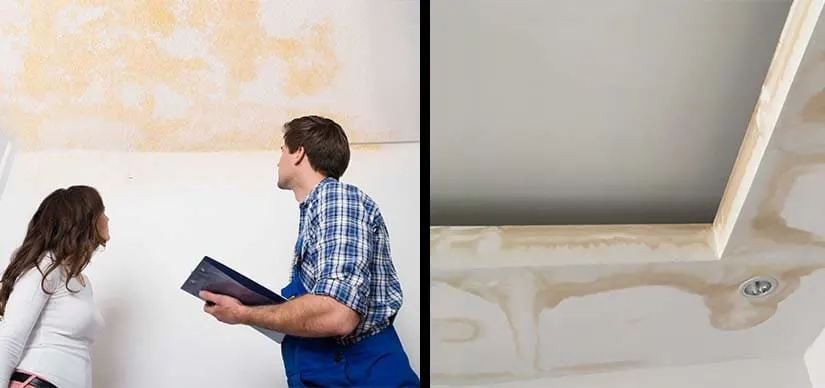How to Properly Inspect Your Ceiling for Signs of Water Damage and Slab Leaks
Views : 855

The structural integrity and aesthetic appeal of your home are greatly influenced by the ceiling. It usually experiences slab leaks and water damage, which can cost a lot to fix and even pose health risks.
As a homeowner in Rancho Bernardo, California, it’s vital to routinely check your ceiling for signs of water damage and slab leaks to identify them early, stop further damage, and possibly avoid water damage restoration.
In this article, we’ll present you with a step-by-step guide on how to properly inspect your ceiling for signs of water damage and slab leaks.
It’s important to understand what leads to slab leaks and water damage before we start. Several factors, such as a leaky roof, broken plumbing, or condensation, can result in water damage in Rancho Bernardo.
Slab leaks happen when the pipes under the foundation of your home start to leak, letting water seep inside. Both of them can lead to water stains, sagging, and mold growth on your ceiling.
How to Properly Inspect Your Ceiling
Step 1: Look for Visible Signs of Water Damage
The first step in inspecting your ceiling for water damage is to look for any visible signs. This can include water stains, discoloration, or sagging.
Water stains are often yellowish or brownish and can be circular or oblong. If you see any of these signs, there is likely water damage to the ceiling above.
Step 2: Check for Soft Spots
After identifying any visible signs of water damage, the next step is to check for soft spots. Water damage can weaken the structure of your ceiling, causing it to become soft and spongy in some areas.
Gently press your fingers into the ceiling to see if there are any soft spots. If you find any, this is a sign that there may be water damage present.
Step 3: Inspect Your Attic
It’s important to examine your ceiling from above, in the attic, in addition to from below. Look for any indications of water damage, such as water stains or mold growth, in your attic.
Pay close attention to the areas near vents and chimneys, which are frequent locations for leaks.
Step 4: Check for Signs of Slab Leaks
Slab leaks can be harder to detect than water damage, but there are still some signs you can look out for. If you notice an unexplained increase in your water bill, it could be a sign that you have a slab leak.
You may also notice warm spots on your floor, a decrease in water pressure, or the sound of running water when no faucets are turned on.
If you suspect you have a slab leak, it’s important to contact a professional plumber to perform a proper inspection and slab leak repair in Rancho Bernardo.
Step 5: Call a Professional
If you do find any signs of water damage or slab leaks during your inspection, it’s important to contact a professional for water damage restoration.
They have the experience, knowledge, and tools to properly assess the extent of the damage and provide you with the best solution for repair and water damage restoration in Rancho Bernardo.
Check your house for external ceiling leaks
Look for external ceiling leaks to find any potential problems that could result in water damage to your house. The steps you can take to check your home for external ceiling leaks are as follows:
Check the roof
Check your roof for any visible damage, such as missing or broken shingles, cracks in the roof, or areas where the roof may be sagging. These can be signs of a potential leak.
Look for debris
Look for any debris that may be obstructing your gutters or downspouts, such as leaves or branches. This might result in water backing up onto the roof and a leak.
Check the flashing
The flashing is the material that seals the joints and seams on your roof. Check for any visible damage or gaps in the flashing that may be causing a leak.
Check the chimney
If you have a chimney, check the area around it for any visible damage, such as cracks or gaps in the chimney flashing. These can be potential sources of a leak.
Check the vents
Check the vents on your roof for any visible damage or gaps in the flashing. These can also be potential sources of a leak.
Check the siding
If you have siding on your home, check for any visible damage, such as cracks or holes, that may be allowing water to seep into your home.
Check the foundation
Check the area around your home’s foundation for any signs of water damage, such as cracks or discoloration.
If you find any signs of external ceiling leaks, it’s important to take action right away. Contact a professional water damage restoration company to assess the damage and provide you with the best solution for slab leak repair in Rancho Bernardo or water damage restoration in Rancho Bernardo.
Remember, the longer you wait, the more extensive the damage can become, so don’t delay in getting the help you need.
What Are the Signs of a Leaking Ceiling?
Understanding the signs of a leaky ceiling can help you spot the issue quickly and take action to stop further damage.
Some of the most typical indications of a leaking ceiling are listed below.
Water stains
One of the most obvious signs of a leaking ceiling is water stains. These are typically brownish or yellowish and may have a circular or oblong shape.
Water stains can appear on your ceiling or walls and are usually a sign that there is a leak in your roof or plumbing.
Dampness or mold growth
A leaking ceiling can also cause dampness or mold growth in your home. Mold thrives in moist environments, so if you notice a musty smell or see signs of mold on your ceiling or walls, you likely leak.
Sagging or bulging
If you notice that your ceiling is sagging or bulging, it’s a sign that water has been accumulating inside your ceiling cavity. This can cause structural damage and even collapse in severe cases.
Peeling paint or wallpaper
A leaky ceiling can also cause your paint or wallpaper to peel or bubble. This is a result of the water soaking into the walls and causing the adhesive to break down.
Cracks in the ceiling
Another sign of a leaking ceiling is cracking in the plaster or drywall. These cracks can be caused by the water weakening the structural integrity of your ceiling.
Strange noises
If you hear strange noises coming from your ceiling, you may leak. You may hear the sound of dripping water or the sound of water moving through your pipes.
Increased utility bills
A leaking ceiling can also cause your utility bills to increase. This is because the water that is leaking out of your ceiling is not being used, but you are still being charged for it.
If you notice any of these signs of a leaking ceiling, you may need slab leak repair in Rancho Bernardo, or water damage restoration in Rancho Bernardo, it’s important to take action immediately.
Conclusion
The ceiling of your home is crucial to its structure and appearance, but it is also susceptible to water damage and slab leaks, which could lead to expensive repairs or even health risks.
As a result, it’s crucial to regularly check your ceiling for evidence of slab leaks and water damage. Finding obvious indications of water damage, such as water stains, discoloration, or sagging, is the first step in the inspection process.
Next, soft spots are looked for. You should also look for any indications of water damage in your attic and possible causes of external ceiling leaks on the exterior of your home.
If you notice any indications of water damage or slab leaks, you should call an expert plumber from EZ Plumbing USA to have the damage assessed and execute slab leak repair in Rancho Bernardo or water damage restoration in Rancho Bernardo immediately.

.jpg)
.jpg)

_11zon.jpg)